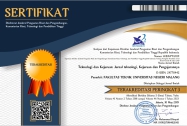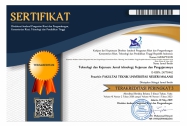Handout sebagai Perangkat Pembelajaran Praktis
Abstract
This learning device development was based on the observation at Public Vocational High School 3 Singaraja where the problems that occurred were 1) students only waited for teachers’ explanation, and 2) no applicative material that made the learning process difficult. The subject of this research and development was Basic Electricity and Electronic teacher from the class of X-TITL 1 in Public Vocational High School 3 Singaraja and its 35 students. The product testing was performed in two stages: 1) limited test, and 2) implementation test. The data instruments were validation and observation sheets, where the measurement aspect from the data collection was learning device validity and learning device practicality. The handout validation results obtained 80.6 percent score, the observation sheet of learning device implementation got 87.5 percent score, and the observation sheet of teacher’s activity obtained 92.6 percent score. The practical test of learning device was based on the analysis and observer assessment on the observation sheet of a learning device and teacher’s activity. The total percentage of learning activity was 80.4 percent (70 percent is less than PR is less than 85 percent), or a good category. The total percentage of teacher activity was 80.8 percent (70 percent is less than PG is less than 85 percent) or an active category. Thus, from two observations above, it could be stated that the learning device met the practicality criteria.
Keywords: handout, valid, practical
Keywords
Full Text:
PDFReferences
Akbar, S. (2013). Instrumen Perangkat Pembelajaran. Bandung: PT. Remaja Rosdakarya. Arikunto, S. (2013). Manajemen Penelitian Edisi 12. Jakarta: PT. Rineka Cipta. Departemen Pendidikan Nasional. (2008). Pengembangan Bahan Ajar dan Media. Jakarta: Departemen Pendidikan Nasional. Direktorat Pembinaan Sekolah Menengah Atas. (2010). Petunjuk Teknis Pengembangan Bahan Ajar. Jakarta: Depdiknas. Dirjen Manajemen Pendidikan Dasar dan Menengah. (2008). Panduan Pengembangan Bahan Ajar. Jakarta: Departemen Pendidikan Nasional. Haviz. (2016). Research and Development, Penelitian Di Bidang Kependidikan yang Inovatif, Produktif Dan Bermakna. Program Studi Pendidikan Biologi STAIN Batusangkar: Program Pascasarjana Universitas Negeri Padang. Kagan, S. & Kagan, M. (2009). Kagan Cooperative Learning. San Clemente, CA: Kagan Publishing. Mertler, C. A. (2012). Action Research: Mengembangkan Sekolah dan Memberdayakan Guru. Yogyakarta: Pustaka Pelajar. Prastowo, A. (2011). Panduan Kreatif Membuat Bahan Ajar Inovatif, Meciptakan Metode Pembelajaran yang Menarik dan Menyenagkan. Jogjakarta: Diva Press.
Jurnal Teknologi, Kejuruan, dan Pengajarannya 169 Prastowo, A. (2014). Pengembangan Bahan Ajar Tematik: Tinjauan Teoritis dan Praktik. Jakarta: Kencana Prenadamedia Group. Puslitjaknov. (2008). Metode Penelitian Pengembangan. Jakarta: Pusat Penelitian Kebijakan dan Inovasi Pendidikan Badan Penelitian dan Pengembangan Departemen Pendidikan Nasional. Richey, R. C., Klein, D.K & Nelson, W. A. (2002). Developmental Research: Studies of Instructional Design and Development. In David Jonassen, (Eds). Handbook of Research on Educational Communications and Technology (2nd Edition). (Online), (http://www.aect.org/edtech/42.pdf), diakses tanggal 19 Mei 2018. Riyadi, A. Soetjipto, B.E. & Amirudin, A. (2016). The Implementation of Cooperative Learning Model Fan-N-Pick and Quick on the Draw to Enhance Social Competence and Cognitive Learning Outcome for Social Studies. IOSR Journal of Humanities and Social Science (IOSR- JHSS). (Online) (http://www. iosrjournals.org), diakses 10 November 2017. Sarnoko, R. & Punadji S. (2016). Penerapan Pendekatan SAVI Berbantuan Video Pembelajaran untuk Meningkatkan Aktivitas dan Hasil Belajar IPS Siswa Kelas IV SDN I Sanan Girimarto Wonogiri. Jurnal Pendidikan: Teori, Penelitian, dan Pengembangan. (Online), (http://journal. um.ac.id/index.php/jptpp/article/view/6524/2785), diakses 10 November 2017. Sugiyono. (2011). Metode Penelitian Kuantitatif, Kualitatif, dan R&D. Bandung: Alfabeta. Susanto, J. (2012). Pengembangan Perangkat Pembelajaran Berbasis Lesson Study dengan Kooperatif Tipe Numbered Head Together untuk Meningkatkan Aktivitas dan Hasil Belajar IPA di SD. Journal of Primary Educational. (Online), (http://journal.unnes.ac.id/sju/index.php/jpe), diakses 10 November 2017.
DOI: http://dx.doi.org/10.17977/um031v42i22019p158-169
Refbacks
- There are currently no refbacks.
Copyright (c) 2020 Teknologi dan Kejuruan: Jurnal Teknologi, Kejuruan, dan Pengajarannya
Teknologi dan Kejuruan: Jurnal Teknologi, Kejuruan, dan Pengajarannya
E-ISSN 2477-0442 (online)
Contact
Faculty of Engineering, Universitas Negeri Malang (UM)
Jl. Semarang No 5 Malang 65145, Building H5, 1st Floor.
Homepage: http://journal2.um.ac.id/index.php/teknologi-kejuruan
Email: teknologikejuruan.ft@um.ac.id

This work is licensed under a Creative Commons Attribution 4.0 International License.



2.png)
1.png)
1.png)
1.png)
4.png)
1.png)
.png)

3.png)
1.png)
1.png)


